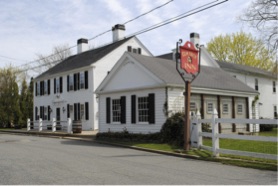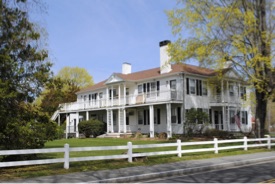by Susan F. Witzell, Archivist
During late 1813 and early 1814 the British war ship Nimrod spent a great deal of time and effort patrolling, blockading and marauding Vineyard Sound, Nantucket Sound, Block Island Sound, the entrance to Narragansett Sound, the eastern end of Long Island Sound and the coast of Cape Cod, the Elizabeth Islands and areas around Buzzards Bay during the War of 1812 between the English crown and the young American republic. The blockade was a cause of great harm to the economy of the young country
Often using the ships’ refuge of Tarpaulin Cove on Naushon Island as a starting point for raids, the English learned fairly easily what was going on nearby. Ships on the high seas were captured, their crews impressed or imprisoned, the cargo seized and the ships themselves sent to Halifax in Nova Scotia, the island of Bermuda or burned.
In late January of 1814 the tactics changed to the threat of land invasion and damage to goods and people not on the high seas. The Nimrod demanded that the town of Falmouth give them a Nantucket boat tied to the dock and also demanded that the local militia turn over their two 3-pounder brass cannons. Captain Weston Jenkins of the militia had fired the cannons at small barges from the Nimrod but this seemed to provoke the English instead of deterring them. When the demand for the cannons was delivered under a flag of truce, he is said to have declared: “Come on, and get them…if you can!”….
The bombardment began at 1 P.M. January 28, 1814. Over 300 cannon balls were shot at the town from the Nimrod’s sixteen 32-pounders and possibly from the barges’ 6-pounders. Sea captain John Crocker, whose large white house was prominently visible up the street from the dock area, had his home severely damaged; the English thought it was the governor’s house. Other captains’ houses and various large dwellings along Main Street all the way to the village green were hit by the balls, causing much damage. Their descendents or later owners have proudly displayed the balls and their damage for almost 200 years.
The severe storms of 2012 into the winter of 2013 caused the coastal bottom to be churned up and revealed objects that had been buried under layers of sand and rock. A scallop fisherman dredging the bottom off the south coast of Falmouth in February and March of 2013 discovered two cannon balls. He turned them over to Chuck Martinsen of Falmouth’s Department of Natural Resources.
Chuck came to us in March and asked for help estimating which houses were hit, where they were (and are) located and to provide any historical information about the Nimrod and her local activities.
Jennifer Gaines had mounted a fascinating exhibit last summer featuring the War of 1812, the activities of the Nimrod and the aftermath of her attack both in Falmouth, around the islands, Buzzards Bay and Wareham. All this information was available to pass along to Chuck.
Using the text of a newspaper account of the bombardment published on February 1, 1814, and written by Captain Crocker (quoted in The Book of Falmouth), I was able to locate the houses affected by using the oldest map available with houses and their locations depicted: The Walling Map of 1858. Since it was only 44 years later, most of the same families remained living in the same houses (the Swifts, the Bournes, the Lewises the Joneses, the Lincolns). It was a simple matter to plot the estimated trajectory of the cannon fire to the houses shown on the map. This was a wonderful opportunity to help the DNR. Chuck had also applied to the state underwater archeological board to survey the area where the scalloper had dredged.

The Elm Arch Inn, the former Captain Silas Jones house, moved around the corner from Main Street.
Later on I photographed the existing houses mentioned: the Crocker house at 100 Shore Street (part of the Shoreway Acres Motel), the Jones house, moved around the corner from its original location on Main Street (now the Elm Arch Inn) and the Nimrod Restaurant (which had been the Bourne and Lewis homes on Main Street), 100 Dillingham Avenue.
On May 4th Jennifer and I were part of a presentation at the Falmouth Public Library hosted by Chuck Martinsen in which the two cannon balls discovered by the shell fisherman were displayed (in an aquarium to keep them from deteriorating in air) as well as another “dry” cannon ball found years ago. It is unknown whether any of these balls were fired by the Nimrod or by the militia cannon but it seems likely that they originated in the bombardment of January 1814.

Captain John Crocker’s house, now 100 Shore Street (part of the Shoreway Acres Inn), still in its original location. Since the British thought this large house was the governor’s, they shot it up badly, causing much damage.
The audience was very lively and interested, asking many questions with pertinent remarks.
At the end of the presentation, a member of the audience came up with a cannon ball he’d owned for years, found under a tree stump in Woods Hole. Instead of having a solid surface it was made of two halves joined with a seam in the center and with holes for fuses on top. Chuck was concerned that this ball could become unstable, with gunpowder still inside, and would be potentially explosive.
He went off to talk to the police and bomb disposal people on his phone. In the meantime, the audience crowded around the three cannon balls on display and spent a lot of time looking at the map of the trajectories, the house photos and asking many questions. This went on for 15 or 20 minutes and then most people left.
Apparently Chuck eventually took the “unstable” cannon ball to his facilities and it was after this that the Massachusetts State Police bomb squad came and took the cannon ball and blew it up. But there was no evacuation or excitement at the conclusion of the presentation, which was enjoyed by all. It was a great pleasure to inform the public about the background for this remarkable discovery.
